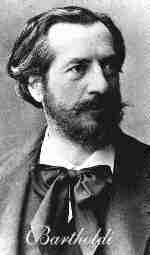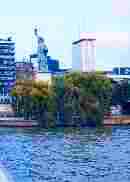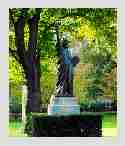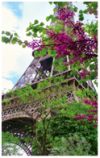|
Statue of Liberty Facts:
Statue of Liberty Cruise
Statue of Liberty Tours
After
Frederic-Auguste Bartholdi prefabricated the figure in Paris by molding sheets of
cooper over a stainless-steel framework, it was shipped to the United States in 241 crates in 1885. Some of the money to erect the statue was contributed by American school children.
The sculptor intended his work to be an immense and impressive symbol of human
liberty. It was certainly that for millions of immigrants who came to America in
the19th century seeking freedom and fulfillment of their dreams. It has continued to
inspire people across the world, as in 1989 when the Chinese students at Tiananmen
Square made a model of the Statue of Liberty to symbolize their revolution. For more
information (and images) about the Statue of Liberty, click
here.
The idea for the Statue of
Liberty germinated in 1865 when the 31 year old
Frédéric Auguste Bartholdi
the Sculptor [who had trained as a painter with Ary [Ari]
Scheffer], and several of his friends, conceived of a monument to the Franco-American alliance of 1778 that brought General Lafayette and his French army to America to fight with Washington in our American Revolution.
What French historian proposed the Statue of Liberty?
In 1870, Bartholdi undertook the design of the statue on his own initiative.
The French historian,
Edouard de Laboulaye
suggested the Statue of Liberty
[1811-83],
in 1865. He began the fund raising with his proposal for the immense statue. The construction funds were raised from the French people.
|
|
 |
Because of the statue's
towering size and weight, the design engineers Eugène-Emmanuel Viollet-le-Duc and
Alexandre-Gustave Eiffel
designed infrastructure of four gigantic steel
supports and supervised their
assembly. |
|
 |
| |
Frederic-Auguste
Bartholdi |
|
|
Alexandre-Gustave Eiffel |
In 1875, fabrication of the copper and steel
Statue of
Liberty Construction in Paris was begun in Paris France. Ten years later, in 1885, the 46 meters [151 feet 1 inch] high statue was completed. It weighed 225 tons upon completion. This same year, the completed statue was
disassembled and shipped to New York. 1885 was also the year that the famed
|
Before Bartholdi and Eiffel built the full scale Statue of Liberty,
they
built several scale models for construction that were
smaller. The smaller of the two models can be found today in the east side of the Jardin de Luxembourg, in a clump of trees not far from the garden's entrance from rue de Medicis, in Paris.
Several bridges west of the Tour Eiffel, just west of the Pont de Grenelle, on its own island, Swan Island [Allée des Cygnes] in the Seine River, is the larger model
which is shown to the right. |
|
 |
Biography
of Frédéric Auguste Bartholdi
Frédéric Auguste Bartholdi was born in
Colmar, Alsace,
France on August 2, 1834. He was the son of Jean-Charles
Bartholdi, a French government employee, and Augusta-Charlotte [né
Beyser]. With his parents, he remained in the house of his
birth, at 30, rue des Marchands, until the death of his father.
Following his father's death, his mother moved the family to Paris
where her young son studied art and Parisian monuments. From
1843 to 1851 he attended the lycée Louis-le-Grand and frequented the
studio of the painter Ary Scheffer. During scholastic
vacations, he would return to Colmar to study with Rossbach.
In 1852, Bartholdi opened his own studio in Paris.
For 9 months, during the year 1855-1856, the young Bartholdi, who
was now 21 years old, went traveled to the Near East with some of
his friends. Among other locations, they visited both Yemen
and Egypt. It was there, during this voyage, that he
discovered the great Nile civilization where only the great
monuments had survived to recount its history. Returning to
France, he brought with him a dedication to sculpturing.
The Franco-Prussian war of 1870 resulted in the ceding of his native Alsace,
together with Lorraine, to Prussia. The removal of
his cherished Alsace from France changed the successful artist
profoundly. His heart was wounded by this loss, and through
discussions with his friend Edouard de Laboulaye expressed his
desire to 'fight for liberty'. He then decided to go to the
United States to further this ambition.
On arriving in New York harbor, Bartholdi saw Bedloe Island as the
place to place an enormous statue to liberty which he quickly
undertook to publicize. In 1872, he created a statue of La
Fayette for the French community of New York. In December,
1876, he married Jeanne-Emilie Baheux in Newport.
In 1875 he began construction of his statue 'Liberty Lighting
the World' which would be installed on Bedloe Island.
The statue was then dismantled and shipped to New York, arriving on
June 19, 1885. It then took four months to rebuild the statue. President Grover Cleveland dedicated the completed statue and pedestal on October 28, 1886.
In addition to his statue of La Fayette, Bartholdi created several other sculptural monuments in America from his numerous trips here during the workings of the Liberty project. For more information on Bartholdi's life and his accomplishments, click here.
Later in 1885, a replica of the
Statue of Liberty was placed on the île des Cygnes in Paris.
During the next few years, copies of this work were installed in
Hanoi and at Bordeaux, France.
Bartholdi died
as the result of an illness in
Paris
on October 4, 1904, at 70 years of age. His tomb can be found on the west side of the
Cimetière du Montparnasse.
Bartholdi's immortal Statue of Liberty was added to UNESCO's World Heritage List in 1984.
On July 4, 2004, the world's largest replica of the Statue
of Liberty was unveiled at Colmar, France. It was made
to commemorate the 100th anniversary of Bartholdi. The
statue stands 12 meters high.
|







